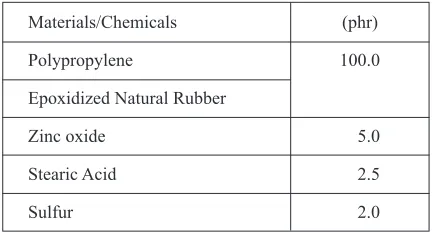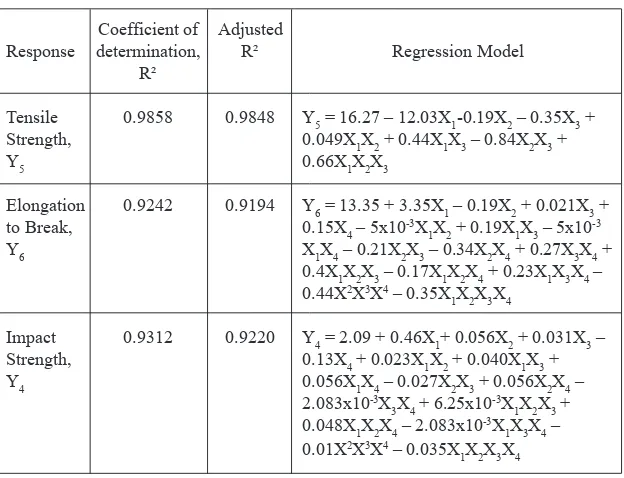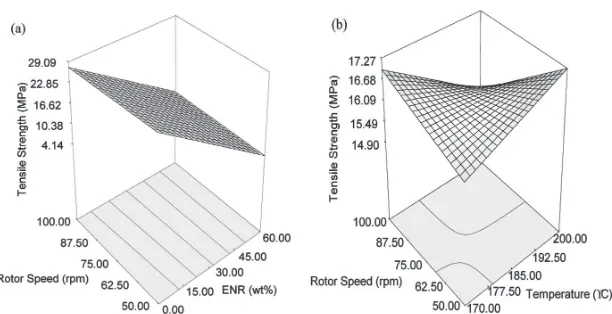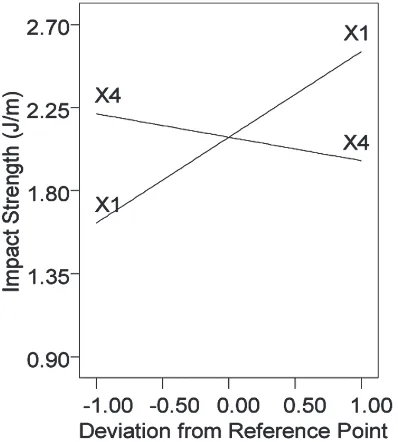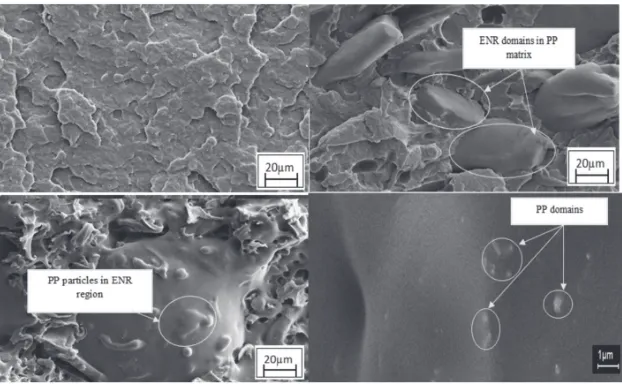ISSN 1823-5514
© 2014 Faculty of Mechanical Engineering, Universiti Teknologi MARA (UiTM), Malaysia.
Interaction of Mixing Factors with
Mechanical Properties of
PP/ENR Blend via Response
Surface Methodology
Noraiham Mohamad, Nur Sharaina Zainol, Faisal Faris Rahim, Mohd Khuzaimi Mohd Salleh, Mohd Asyadi ‘Azam, Mohd Yuhazri Yaakob, Mohd Edeerozey Abd Manaf
Department of Engineering Materials, Faculty of Manufacturing Engineering
Universiti Teknikal Malaysia Melaka, Durian Tunggal, 76100 Melaka, Malaysia
Phone: +606-3316976, Fax: +606-3316411, Email: [email protected]
Hairul Effendy Ab Maulod
Department of Manufacturing Engineering Technology, Faculty of Engineering Technology,
Universiti Teknikal Malaysia Melaka, Durian Tunggal, 76100 Melaka, Malaysia
Mohd Fadzli Abdollah, Department of Automotive, Faculty of Mechanical Engineering,
Universiti Teknikal Malaysia Melaka, Durian Tunggal, 76100 Melaka, Malaysia
ABSTRACT
properties of PP/ENR blends. It was clearly observed that high ENR to PP ratio increases the toughness and lexibility of the PP/ENR blends. In comparison to the pure PP, PP/ENR blend with 40% ENR showed improvement of elongation at break and impact strength up to 68% and 56%, respectively. In contrary, the tensile strength and hardness decreases as the amount of PP decreases. The changes were associated to the properties imparted by the elastic chains of cross-linked ENR. The obtained properties showed good correlation with fracture surfaces observed in microscopy analysis performed by Field Emission Scanning Electron Microscope at magniications of 500 and 5000-x.
Keywords: Polypropylene; epoxidized natural rubber; blend; factorial design,
mechanical properties
Introduction
Blending of thermoplastic and elastomeric polymer generates a new class of material termed thermoplastic elastomer (TPE) with combined properties of its constituent. It is a common technology that frequently applied in order to develop products with superior mechanical properties from inexpensive polymer material [1].
TPEs received attention from researchers all over the world due to their versatile function in various automotive parts, household appliances, electrical equipments, industrial supplies, food contact systems and medical apparatus [2]. TPEs can be classified into two groups: block copolymers and rubber-plastic blend. Thermorubber-plastic vulcanizates (TPV) or dynamic vulcanizates (DV) is a class of TPE based on rubber and thermoplastic compositions where the rubber which is later crosslink under dynamic conditions. The one based on natural rubber and thermoplastic blends are classified as ‘thermoplastic natural rubber’ (TPNR) blends. There are two types of TPNRs; 1) The thermoplastic polyolefin (TPO) which is prepared by blending NR with thermoplastic such as polyolefin to obtain co-continuous phase morphology, 2) The ‘thermoplastic vulcanizate (TPV)’ which is prepared by blending NR with polyolefins where the rubber phase is vulcanized during the mixing process at high temperature by a process known as ‘dynamic vulcanization (DV)’ [3].
Polypropylene (PP) is a polymer with large molecular weight distribution [4]. There are three types of PP, i.e., atatic (aPP), isotactic (iPP) and syndiotactic (sPP) [5]. PP has wide range of application due to its unique properties such as high melting temperature, low density, high chemical resistance, and resistance to heat. On the other hand, PP exhibits poor impact strength which gives limitation to several other applications [6].
while retaining most of the properties of natural rubber [7]. The epoxidation of natural rubber can be performed using peracid which is generated from the reaction of formic acid and hydrogen peroxide [8]. The properties of ENR are gradually changed with increasing degree of epoxidation [8]. The presence of epoxy groups in rubber chains imparts great properties to natural rubber such as oil resistance, low gas permeability, good wet grip and high damping characteristics [9-12].
Melt compounding via internal mixer is a widely used technique to prepare polymer compounds and blends [10]. Uniform compounding is achieved when the materials are sheared in control manner between two circulating rotors. Besides rotational speed, other processing parameters such as mixing temperature and mixing time are important factors to improve blends miscibility as well as its properties. The interactions between these parameters should be established to understand its contribution towards process optimization. Statistical and mathematical approach is a useful technique to correlate between factors and response due to less time consuming and has the ability of detecting the true optimum of the factor [10]. Response surface methodology (RSM) is commonly used technique due to its reliability [13, 14, and 15]. It allows simultaneous evaluation number of factors and eliminates the need for a large number of independent experiments that are otherwise required in a conventional one-factor-at-a-time or trial-and-error approach [16].
Table 1: Formulation of PP/ENR blend
Materials/Chemicals (phr)
Polypropylene 100.0
Epoxidized Natural Rubber
Zinc oxide 5.0
Stearic Acid 2.5
Sulfur 2.0
Mixing and preparation of sample
The blending process of PP/ENR blends was performed according to ASTM D 3192 and carried out using a Haake internal mixer working with combination of parameters determined by the design of experiment. Firstly, PP and ENR were blended together in mixing chamber before all ingredients were added in sequential. Finally, sulphur was added and mixed for about 2 minutes to complete the dynamic vulcanization process. Then, the mixture was dumped and left to cool to room temperature for 24 hours. Subsequently, the produced TPV blend was pressed using hot press (GT7014-A, Gotech) for about 5 minutes at 185°C and 176 MPa before undergone cutting process. Samples prepared according to ASTM standard were conditioned at room temperature for 24 hours before testing.
Experimental design
Experimental design to correlates mixing parameters with mechanical properties of PP/ENR blend was based on two level factorial designs generated using the Design Expert 6.0.10 software. Four factors were investigated; ENR content, X1 (%), mixing temperature, X2 (oC), rotor speed, X
Table 2: Combination of parameters internal mixer machine for 24 factorial designs for screening factor
Std ENR Temperature Rotor Speed Time
X1 (%) X2 (oC) X
3 (rpm) X4 (min)
1 -1 -1 -1 -1
2 1 -1 -1 -1
3 -1 1 -1 -1
4 1 1 -1 -1
5 -1 -1 1 -1
6 1 -1 1 -1
7 -1 1 1 -1
8 1 1 1 -1
9 -1 -1 -1 1
10 1 -1 -1 1
11 -1 1 -1 1
12 1 1 -1 1
13 -1 -1 1 1
14 1 -1 1 1
15 -1 1 1 1
16 1 1 1 1
17 0 0 0 0
18 0 0 0 0
Table 3: Level of variables for the screening factor
ENR Temperature Rotor Speed Time
(X1; %) (X2; oC) (X
Tensile test was carried out according to ASTM D638. It is the most common plastic strength specifications and covers the tensile properties of unreinforced and reinforced plastics. This test conducted on standard “dumbbell” or “dogbone” shaped samples with 3 mm thickness. Dumbbell samples of PP/ENR blends were cut from moulded sheets using a cutter machine (Gotech). The tensile test was performed using Universal Testing Machine (Autograph AG-IC, Shimadzu Scientific Instruments) at a cross head speed of 2.0 mm/min and 25± 5 °C. Samples prepared according to ASTM D 256 were tested for impact strength using Izod pendulum impact tester. In the test, un-notched specimen was held as a vertical cantilevered beam and impacted by a pendulum.
The examination of the impact fracture surfaces were carried out using a scanning electron microscope (ZEISS EVO 50) at magnifications of 500x and 5000x under variable pressure. For every sample, a minimum of three micrographs at each magnification were taken to ensure a high confidence level in the analysis. The fractograph was observed and the morphology was analyzed qualitatively.
Results and Discussions
Mechanical properties
Table 4: Regression model for every response
Coefficient of Adjusted
Response determination, R² Regression Model
R²
model is accurate in describing and predicting the pattern of significance for each factors [14].
Three dimension interactions between rotor speed-ENR and rotor speed-temperature towards tensile strength are shown in Figure 1 (a) and (b), respectively. It can be seen that the tensile strength decreases with increasing rubber content in the blends. Meanwhile, rotor speed in the range of 50 to 100rpm show trivial effect to tensile strength. In contrast, interaction between rotor speed and temperature at constant ENR value decreased the maximum stress experienced by the blend (Figure 1(b)). This is due to the fact that polymeric materials are heat sensitive and increasing both mixing factors (rotor speed and temperature) at the same time could generate excessive heat which may expose the blend to degradation.
in occlusion and accounts for the decrease in tensile strength. The molecular entanglements in the rubber chains prevent rapid flow and disturb the ability of PP to move [20] and to be strain-crystallized in response to the applied stress. The decrease in tensile strength could also possibly due to the decrease in crytallinity as reported by George et al. [21]. According to them [21], rubber particles present in inter- and intra-spherulitic region of the crystalline phase plastic. It is supposed that the presence of rubber particles in the blend interrupts the formation of crystallite and decreases the crystallinity, which consequently results in lower tensile strength of the PP/ENR blend when compared to pure PP.
As presented in Figure 2, the elongation at break (EB) value increases with the increase of ENR in PP/ENR blends. The result shows that addition of ENR contributes for better elasticity, toughness and flexibility of the material. The ability of the material to absorb energy improves as the rubber content increases since crosslinking in rubber phases (ENR-50) will impart the elastic behaviour to the blend [22]. Besides, it is reported that the addition of ENR into PP increases the inter-planar distance (d value), which indicates the presence of rubber particles in the intra-spherulitic structure of PP [23]. The system experienced reversal as concentration of ENR increased more than 50 wt% due to the occlusion of rubber particles.
Figure 3 shows the perturbation plot of factor X1 (ENR content) and X4 (mixing time) towards impact strength of PP/ENR blends. It can be observed that ENR content has positive contribution whereas mixing time shows negative contribution towards the impact strength. Higher impact strength represents higher resistance of the material to fracture under impact loading. This is related
Figure 2: Elongation at break versus ENR content of PP/ENR blends.
to toughness of the material whereby it measures the ability of the material to withstand both plastic and elastic deformations. It depicts the amount of energy required by the material to break the bonds before fracture. The blend with 60 wt% ENR showed the highest impact strength in the range of 2.1 to 2.7 J/m. It is improvement of 56% if compared to pure PP. The result suggests that ENR is a good candidate to increase the toughness and flexibility of thermoplastic material. The decrease in impact strength with mixing time may due to the tendency of polymeric chains to break down into shorter chains with time and limit the blend’s ability to absorb higher energy.
Morphological Analysis
Figure 4 shows the tensile fracture surfaces of PP, PP/ENR with 30% ENR and PP/ENR with 60% ENR. The dark and bright phases represent ENR and PP, respectively. Most of the fracture surfaces show spherical shaped dimples from pulled-out of PP domains or ENR domains except for the fractograph of unfilled PP, as shown in Figure 4(a). The fractograph of the unfilled PP shows characteristics of ductile fracture under uniaxial tensile loads with the obvious pattern of shear yielding on the surface. In Figure 4(b), fracture surface of PP/ENR (70/30) blend reveals that the ENR were dispersed as domains in a continuous PP phase. This is the stage where ENR is present in the intra-spherulitic structure of PP. In Figure 4(c), the ENR phase started to enlarge
Figure 4: Scanning electron micrograph of (a) unfilled PP, (b) 70/30 PP/ ENR and (c) 40/60 PP/ENR at magnification of 500x (d) 40/60 PP/ENR at
its size and formed bigger ENR domains in PP matrix. In addition, there were smaller PP domains (PP particles) situated in ENR phases as depicted in Figure 4(d). It clearly shown the condition where occlusions of ENR phase started to form as the concentration of rubber matrix higher than 50 wt% in the blend; with the presence of PP particulates trapped in the ENR regions.
Conclusion
As a conclusion, mixing parameters as well as formulation play major roles in the mechanical properties of PP/ENR blend. Suitable combination of mixing parameters could increase miscibility of the blend and avoid chains degradation during processing. Besides, it was found that PP/ENR at high rubber content shows an improvement in its toughness and flexibility. In contrast, the addition of rubber content lowers the tensile strength of the blend due to the reduction in rigidity associated to the PP chains. These properties are also contributed by PP ability to be strain-crystallized. The presence of cross linking in the rubber matrix of PP/ENR blends imparts elastic behavior to PP matrices due to rubber-like properties introduced by the ENR.
Acknowledgements
The authors are grateful to the Universiti Teknikal Malaysia Melaka for financial support in short-term grant research with project no. of PJP/2011/ FKP (33A) S999.
References
[1] M. Zurina, H. Ismail, and C.T. Ratnam. (2006). “Characterization of irradiation-induced crosslink of Epoxidised Natural Rubber/Ethylene Vinyl Acetate (ENR-50/EVA) blend,” Polymer Degradation and Stability 91, 2723-2730.
[2] C.P. Rader. (2003). Thermoplastic Elastomer, Fundamental of Rubber Technology: Apragmatic In-Depth Introduction to the Compounding and Processing of Rubber, Rubber Division.
[3] A.M. Gessler, W.H. Haslett. (1962). US Pattent 3, 037, 954.
[4] T. Meyer, and J. Keurentjes. (2005). Handbook of Polymer Reaction Engineering (WILEY-VCH Verlag GmbH & Co., pp. 883
[6] H.M. da Costa, V.D. Ramos, W.S daSilva, and A.S. Sirqueira. (2010). “Analysis and optimization of polypropylene(PP)/ethylene–propylene– diene monomer (EPDM) /scrap rubber tire (SRT) mixtures using RSM methodology,” Polymer Testing, 29, 572-578.
[7] M.Pire, S. Norves, I. Iliopoulos, B.L Rossignol, and L. Leibler. (2010). “Epoxidized Natural Rubber/Dicarboxcylic Acid self-vulcanized blends,” Polymer, 5, 5903-5909.
[8] W.B. Liau. (1998). “Dynamic Mechanical Relaxation of Lightly Cross-Linked Epoxidized Natural Rubber,” Polymer, 40, 599-605.
[9] N. Mohamad, A. Muchtar, M.J. Ghazali, D.H Mohd, C. H. Azhari and Che Husna Azhari. (2008). “The Effect of Filler on Epoxidised Natural Rubber-Alumina Nanoparticles Composites,” European Journal of Scientific Research, 24(4), 538-547.
[10] N., Mohamad, A. Muchtar, M.J Ghazali, D.H. Mohd and C. H Azhari. (2010). “Epoxidized Natural rubber-Alumina Nanoparticle Composites: Optimization of Mixer Parameter via Response Surface Methodology,” Journal of Applied Polymer Science, 7, 183-189.
[11] A. Thitithammawong, C. Nakason, C.K. Sahakaro, and J. Noordermee. (2007). “Effect of different types of peroxides on rheological, mechanical, and morphological properties of thermoplastic vulcanizates based on natural rubber/polypropylene blends,” Polymer Testing, 26, 537-546. [12] N.Mohamad, A. Muchtar, M.J. Ghazali, H.M. Dahlan. and C.H. Azhari.
(2011). “Investigation on Impact Fracture of Epoxidized Natural Rubber-Alumina Nanoparticle Composites (ENRAN),” Global Engineers and Technologists Review, 1(2), 26-34.
[13] Byeng D. Youn and Kyung K. Choi. (2004). “A New Response Surface Methodology for Reliability-Based Design Optimization,” Computers & Structure, 82, 241-256.
[14] Fenfen Xiong, Yu Liu, Ying Xiong and Shuxing Yang. (2012). “A Double Weighted Stochastic Method for Relability Analysis,” Journal of Mechanical Science and Technology, 26(8), 2573-2580.
[15] D. Bas, H. Ismail and J. Boyaci. (2007). “Modeling and Optimization Usability of Response Surface Methodology,” Journal of Food Engineering, 78, 836-845.
[16] S.Raissi, and R.E. Farsani. (2009). “Statistical process optimization thorugh multi-response surface methodology,”World Academy of Science, Engineering and Technology, 51 (46), 267-271.
[17] N.Mohamad, Z. Nur Sharafina, and A.R. Jeefferie. (2013). “Morphological & mechanical properties of polypropylene/epoxidized natural rubber thermoplastic vulcanizates treated with maleic anhydried-grafted polypropylene,” International Conference on Mechanical Engineering Research
[18] C.Nakason, A.Worlee, and S. Salaeh. (2008). “Effect of vulcanization systems on properties and recyclability of dynamically cured epoxidized natural rubber/polypropylene blends,” Polymer Testing, 27, 858-869. [19] M.M.H. Senna, and Y.K. Abdel-Monem. (2010). “Effect of Electron
Beam Irradiation and Reactive Compatibilizers on Some Properties of Polypropylene and Epoxidized Natural Rubber Polymer Blends,” Journal of Elastomers and Plastics, 42(3), 275-295.
[20] A.R. Jeefferie, N. Mohamad, and H.E. Ab Maulod, “Processability of Polypropylene-Multiwalled Carbon Nanotubes (PP/MWCNTs) nanocomposites via direct melt compounding,” Journal of Elastomers & Plastics. (ISSN 0095-2443), First published on July 10, 2012 as doi:10.1177/0095244312451935.
[21] S. George, K.T. Varughese, and S. Thomas. (2000). “Thermal and crystallisation behaviour of isotactic polypropylene/nitrile rubber blends,” Polymer, 41, 5485-5503.
[22] H. Ismail, D. Galpaya and Z. Ahmad. (2009). “The Compatibilizing Effect of Epoxy Resin (EP) on Polypropylene/Recycled Acrylonitrile Butadiene Rubber (NBRr) blends,” Polymer Testing 28, 363-370. [23] M.A. Lopez-Manchado, and M. Arroyo. (2001). “Effect of the
